Brooklyn Botanic Garden is famous in horticultural circles for introducing the yellow-flowering magnolia to the world, but the Garden’s magnolia breeding program has a deep history that’s not as well known, even to gardeners who may have planted one of the trees in their own garden.
The Garden launched the program in 1953 at its R&D facility, the Kitchawan Research Center, in Ossining, New York. By 1991, when the program ended, BBG had developed eight magnolia hybrids that are still on the market today. This year, all eight hybrids will once again be represented in BBG's collection, providing an important link with the Garden’s history. They are among the later-blooming magnolias, and most flower between mid-April and mid-May.
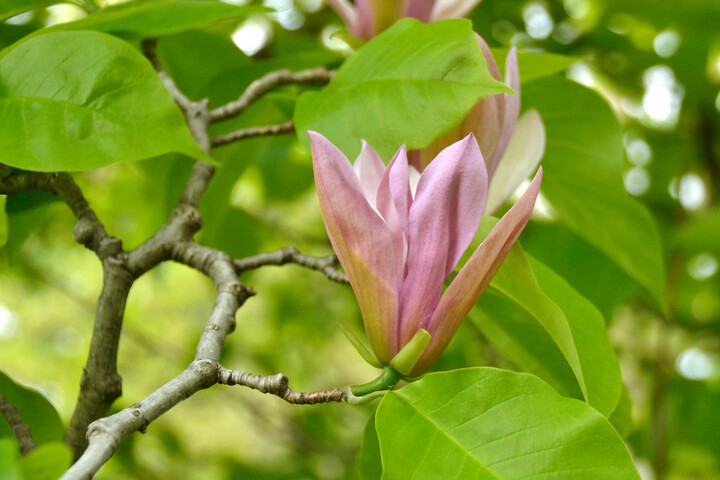
Magnolia x brooklynensis ‘Evamaria’
Introduced: 1972
Cross: Magnolia acuminata and M. liliiflora
Location at BBG: Coming later this year
This small tree is considered the first successful cross ever achieved between an American species—the cucumber tree (Magnolia acuminata)—and an Asian species—the mulan (M. liliiflora). Its name honors its breeder, Dr. Evamaria Sperber, who helped start BBG’s breeding program and whose influence on magnolia breeding cannot be overestimated. ‘Evamaria’ was the first of the brooklynensis hybrids, which brought an increased hardiness and expanded color palette previously unseen in magnolias. Its flowers are an unusual purplish color with varying tinges of orange, yellow, and green. Its hardiness results from using a North American parent—our native magnolias bloom much later than Asian ones.
Breeding with this native parent was not known to have been done before and represented “a major paradigm shift in magnolia development,” according to the Magnolia Society International’s fall/winter 2011 journal. We currently have one specimen of ‘Evamaria’ in our nursery, and I’m hoping to plant it in later this year.
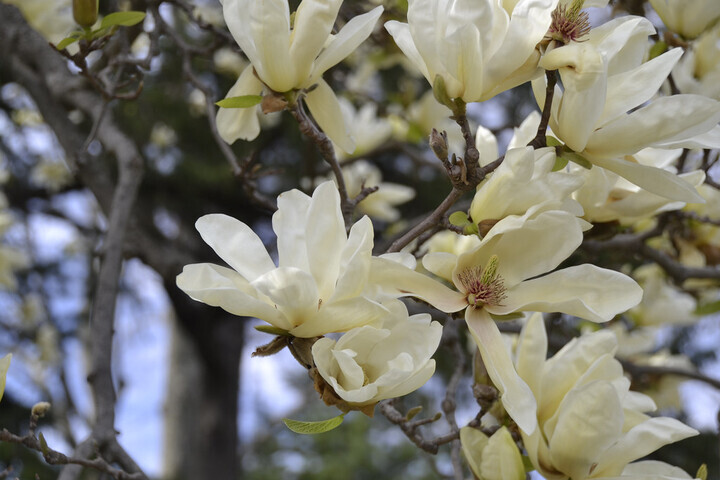
Magnolia ‘Elizabeth’
Introduced: 1977
Cross: M. acuminata and M. denudata
Locations at BBG: Western edge of Magnolia Plaza, near Daffodil Hill; Osborne Garden
Magnolia ‘Elizabeth’, also bred by Dr. Sperber, was the first precocious yellow-flowering magnolia. The term “precocious” refers to plants that flower before they leaf out—a quality that’s highly valued, especially in magnolias, because of the elegant display made by the flowers on bare branches. ‘Elizabeth’ is the perfect balance between its parents. The color of its creamy-yellow flowers comes from the deep yellow flowers of the native cucumber tree and the ivory ones of the yulan magnolia (M. denudata), a Chinese species. Its later bloom time, inherited from the cucumber tree, helps it avoid damage from frost and cold snaps; its precocious habit is from the yulan. Flowers bloom about a week after the saucer magnolias and two or three weeks after the star magnolias.
The hybrid’s name honors Elizabeth Van Brunt, a friend and benefactor of the Garden and from whom the Garden received the Kitchawan site for its research facility.
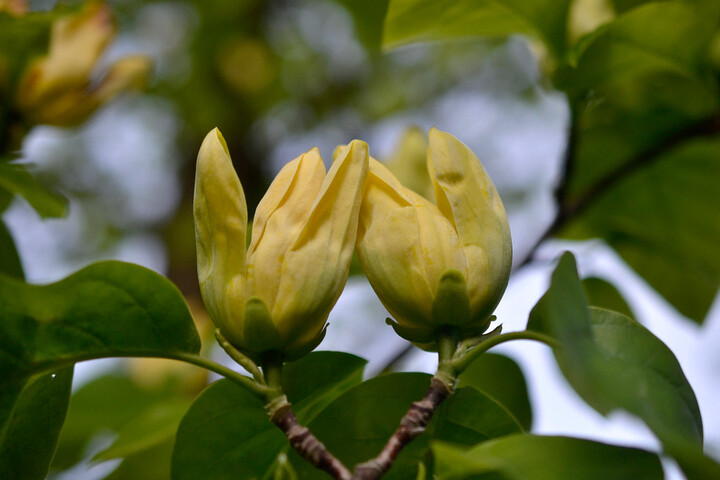
Magnolia x brooklynensis ‘Yellow Bird’
Introduced: 1981
Cross: Magnolia x brooklynensis ‘Evamaria’ and M. acuminata var. subcordata
Location at BBG: Rosaceae section of the Plant Family Collection, just beyond the southwest perimeter of Magnolia Plaza
The second yellow magnolia introduced by BBG, ‘Yellow Bird’ is a backcross—a cross between a hybrid back to one of its parents (or something genetically similar) to create progeny with traits closer to that original parent. In this case, ‘Yellowbird’ gets its deep yellow blossoms and later bloom time from M. acuminata var. subcordata. The trade-off for later blooms is less precociousness. ‘Yellow Bird’ blossoms are surrounded by more leaves than those of ‘Evamaria’ and ‘Elizabeth’.
This hybrid was bred by Doris Stone, another important plantsperson in BBG’s breeding program. Stone is also the author of The Lives of Plants (Scribner, 1982) and was director of Education at BBG for many years.
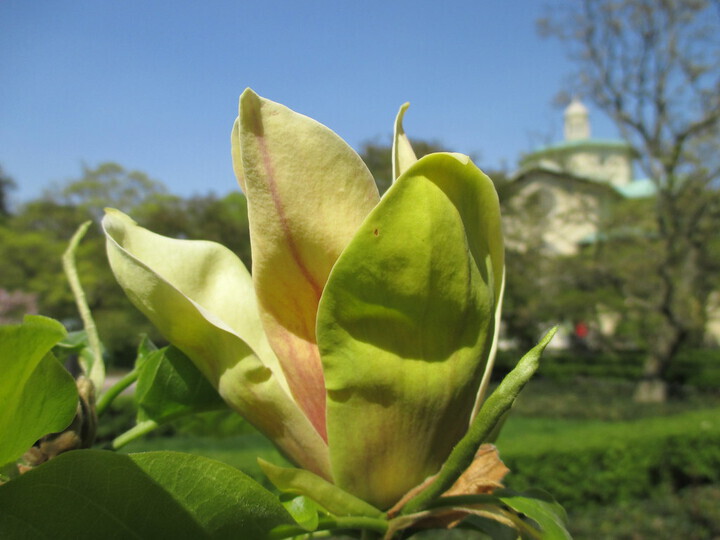
Magnolia x brooklynensis ‘Hattie Carthan’
Introduced: 1984
Cross: Magnolia x brooklynensis ‘Evamaria’ and unnamed brooklynensis hybrid (#209)
Location at BBG: Semicircular border along the southwest perimeter of Magnolia Plaza
Another brooklynensis hybrid by Doris Stone, ‘Hattie Carthan’ has a yellow flower with magenta-rose veins running up from the base of its tepals. This hybrid is named in honor of Hattie Carthan, a community activist and environmentalist from the Bedford-Stuyvesant neighborhood of Brooklyn. Carthan’s many accomplishments include saving what was likely a century-old Magnolia grandiflora in her neighborhood and having it designated a city landmark. She also oversaw more than 100 block associations—responsible for planting more than 1,500 trees in Brooklyn over the years—and founded the Magnolia Tree Earth Center in 1972, a center for environmental and horticultural education that stills exists today.
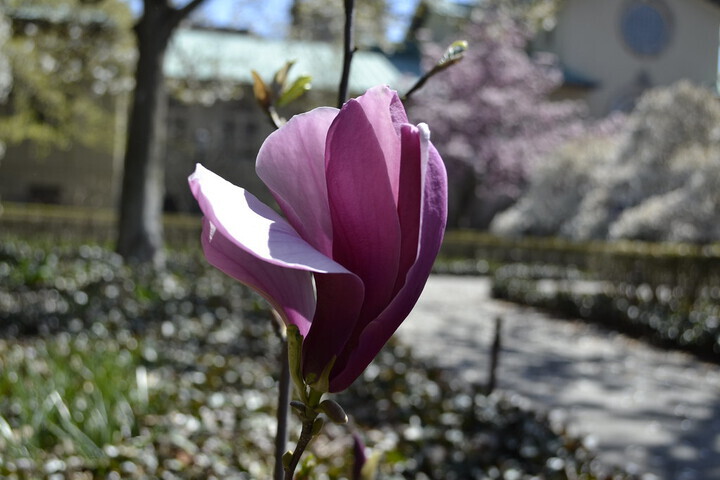
Magnolia ‘Marillyn’
Introduced: 1989
Cross: Magnolia liliiflora ‘Nigra’ and M. kobus
Location at BBG: Semicircular border along the northwest perimeter of Magnolia Plaza
Although it was the last introduction before the breeding program ceased operations, ‘Marillyn’ was one of the earliest crosses, having been bred by Dr. Sperber in 1954. Very similar to the Girl Magnolias, a hybrid series developed by the National Arboretum, ‘Marillyn’ is a small tree or large shrub that bears purple-magenta flowers with white interiors. ‘Marillyn’ honors Marillyn Wilson, a friend and benefactor of the Garden who also served on BBG’s board of trustees.
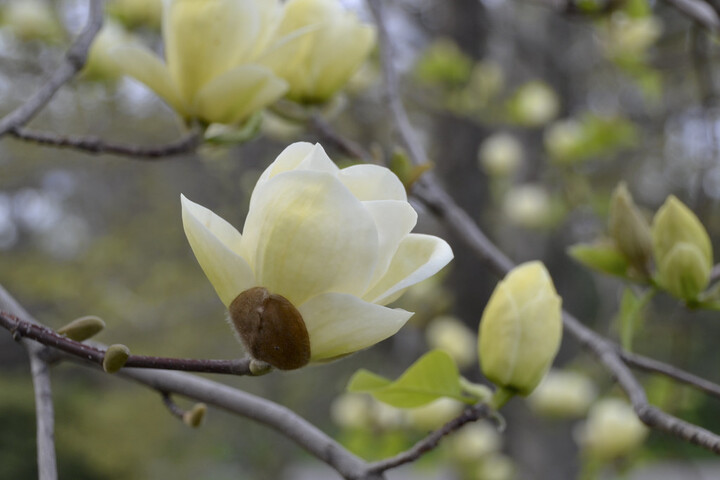
Magnolia ‘Lois’
Introduced: 1998
Cross: An unnamed ‘Elizabeth’ sibling (#850) and M. acuminata
Location at BBG: Rosaceae section of the Plant Family Collection, just beyond the southwest perimeter of Magnolia Plaza
Before the breeding program ended, there were a few unnamed hybrids that had shown promise but had never made it through the registration process to be formally introduced. One of these became Magnolia ‘Lois’, another Brooklyn yellow, introduced in 1998. ‘Lois’, a backcross of a sibling of ‘Elizabeth’ with M. acuminata, has more intense yellow flowers that appear later, as ‘Elizabeth’ is wrapping up its bloom season.
The cross was made by Dr. Lola Koerting, the director of the breeding program from the early 1970s until its closure in 1991. This name honors the late Lois Carswell, who served as chair of the BBG Board of Trustees and cochair of BBG’s annual Plant Sale.
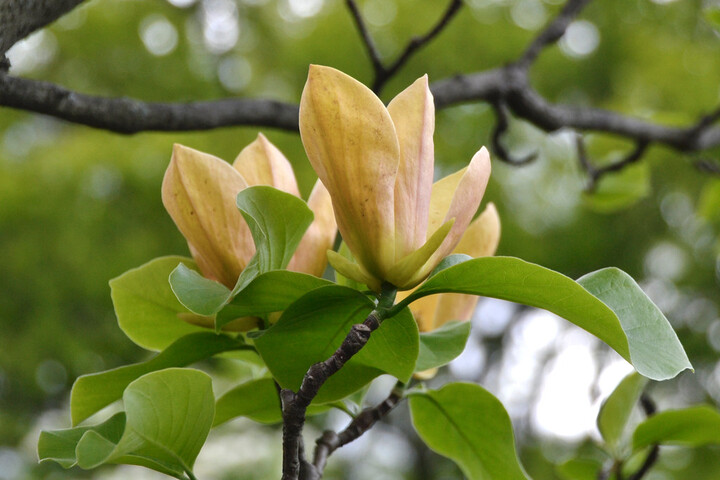
Magnolia ‘Judy Zuk’
Introduced: 2007
Cross: Complex cross of M. acuminata, M. liliiflora, and M. stellata
Location at BBG: Lawn just beyond the southwest perimeter of Magnolia Plaza
The second post-program introduction was Magnolia ‘Judy Zuk’. A complex cross hybrid, ‘Judy Zuk’ is a rather columnar tree, with dark yellow flowers that have tinges of pink rising from the base. While not technically a brooklynensis hybrid, its similar parentage gives it a similar flower.
This hybrid was popular in the magnolia world even before its introduction, when it was still known to many by its test plot number from Kitchawan—#1164. It is named in honor of Judith D. Zuk, horticulturist, educator, and president of BBG from 1990 to 2005.
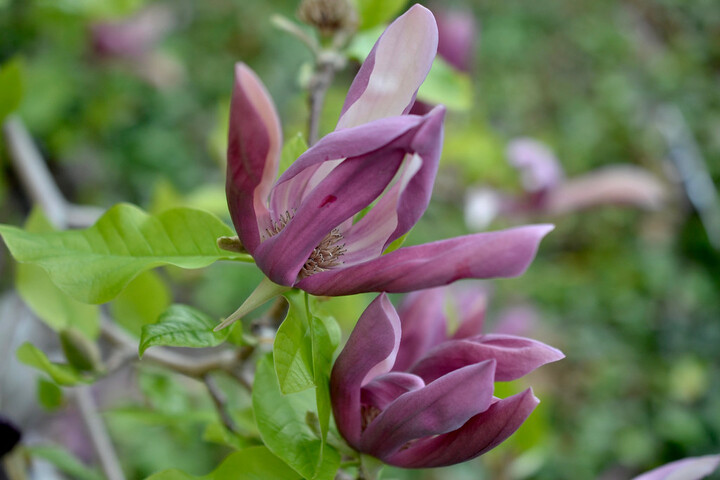
Black Beauty Magnolia (Magnolia x brooklynensis “#204”)
Appeared in market: 2001
Cross: Magnolia acuminata and M. liliiflora
Location at BBG: Magnolia Plaza, near Administration building at the top of the steps to Lily Pool Terrace
The last hybrid of note is one that is as yet unregistered and only unofficially named by the industry. Magnolia x brooklynensis “#204” showed up in the spring 2001 catalog of Fairweather Gardens Nursery, in New Jersey, as ‘Black Beauty’, and the name, unofficial though it is, has stuck. Popular for its deep purple flower with white interior, Black Beauty is also extremely hardy, to USDA Zone 4.
Of course, the BBG program’s influence on the world of magnolia breeding ranges far beyond the Garden itself. Since the introduction of ‘Evamaria’, ‘Elizabeth’, and the other Brooklyn yellows, subsequent hybrids from breeders all over the world continue to build upon the work of Sperber, Stone, and Koerting. In that sense, the spirit of BBG’s breeding program will live on.